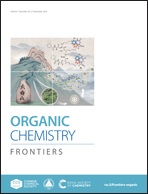Mechanistic study on the regioselective Ni-catalyzed dicarboxylation of 1,3-dienes with CO2†
Abstract
Ni-Catalyzed dicarboxylation of 1,3-dienes with CO2 provides a regioselective method for the construction of adipic acids. Here, density functional theory (DFT) calculations have been carried out to elucidate the detailed mechanisms of this reaction and the origin of regioselectivity. The computed results reveal that the catalytic cycle mainly proceeds via Ni(0)-catalyzed 1st carboxylation, followed by a reduction of the Ni(II) to Ni(I) intermediate and finally a Ni(I)-catalyzed 2nd carboxylation. The first and second carboxylations are rate- and regioselectivity-determining steps, respectively. In the first carboxylation, a new activation mode of CO2 by insertion into the uncoordinated alkene group has been found to be optimal. This is in contrast to other mechanisms described in the literature. Furthermore, we found that the interaction between the allyl group and nickel center in the alkyl Ni(I) intermediate significantly stabilizes the d9 electron configuration. This stabilizing interaction results in the preferential 1,4-dicarboxylation.



 Please wait while we load your content...
Please wait while we load your content...